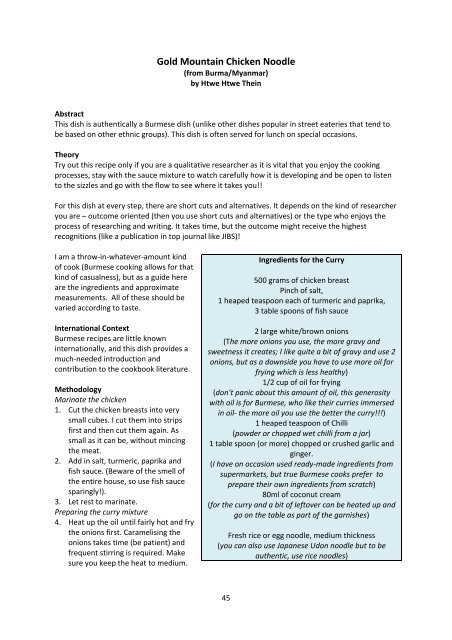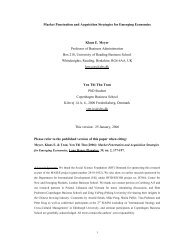AIB Cooking Book - Klaus Meyer homepage
AIB Cooking Book - Klaus Meyer homepage
AIB Cooking Book - Klaus Meyer homepage
Create successful ePaper yourself
Turn your PDF publications into a flip-book with our unique Google optimized e-Paper software.
Gold Mountain Chicken Noodle<br />
(from Burma/Myanmar)<br />
by Htwe Htwe Thein<br />
Abstract<br />
This dish is authentically a Burmese dish (unlike other dishes popular in street eateries that tend to<br />
be based on other ethnic groups). This dish is often served for lunch on special occasions.<br />
Theory<br />
Try out this recipe only if you are a qualitative researcher as it is vital that you enjoy the cooking<br />
processes, stay with the sauce mixture to watch carefully how it is developing and be open to listen<br />
to the sizzles and go with the flow to see where it takes you!!<br />
For this dish at every step, there are short cuts and alternatives. It depends on the kind of researcher<br />
you are – outcome oriented (then you use short cuts and alternatives) or the type who enjoys the<br />
process of researching and writing. It takes time, but the outcome might receive the highest<br />
recognitions (like a publication in top journal like JIBS)!<br />
I am a throw‐in‐whatever‐amount kind<br />
of cook (Burmese cooking allows for that<br />
kind of casualness), but as a guide here<br />
are the ingredients and approximate<br />
measurements. All of these should be<br />
varied according to taste.<br />
International Context<br />
Burmese recipes are little known<br />
internationally, and this dish provides a<br />
much‐needed introduction and<br />
contribution to the cookbook literature.<br />
Methodology<br />
Marinate the chicken<br />
1. Cut the chicken breasts into very<br />
small cubes. I cut them into strips<br />
first and then cut them again. As<br />
small as it can be, without mincing<br />
the meat.<br />
2. Add in salt, turmeric, paprika and<br />
fish sauce. (Beware of the smell of<br />
the entire house, so use fish sauce<br />
sparingly!).<br />
3. Let rest to marinate.<br />
Preparing the curry mixture<br />
4. Heat up the oil until fairly hot and fry<br />
the onions first. Caramelising the<br />
onions takes time (be patient) and<br />
frequent stirring is required. Make<br />
sure you keep the heat to medium.<br />
45<br />
Ingredients for the Curry<br />
500 grams of chicken breast<br />
Pinch of salt,<br />
1 heaped teaspoon each of turmeric and paprika,<br />
3 table spoons of fish sauce<br />
2 large white/brown onions<br />
(The more onions you use, the more gravy and<br />
sweetness it creates; I like quite a bit of gravy and use 2<br />
onions, but as a downside you have to use more oil for<br />
frying which is less healthy)<br />
1/2 cup of oil for frying<br />
(don’t panic about this amount of oil, this generosity<br />
with oil is for Burmese, who like their curries immersed<br />
in oil‐ the more oil you use the better the curry!!!)<br />
1 heaped teaspoon of Chilli<br />
(powder or chopped wet chilli from a jar)<br />
1 table spoon (or more) chopped or crushed garlic and<br />
ginger.<br />
(I have on occasion used ready‐made ingredients from<br />
supermarkets, but true Burmese cooks prefer to<br />
prepare their own ingredients from scratch)<br />
80ml of coconut cream<br />
(for the curry and a bit of leftover can be heated up and<br />
go on the table as part of the garnishes)<br />
Fresh rice or egg noodle, medium thickness<br />
(you can also use Japanese Udon noodle but to be<br />
authentic, use rice noodles)



